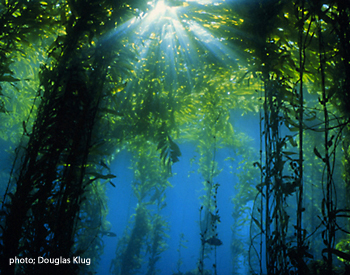Protecting Our Aquatic Backyard
National Sanctuary and Park Collaborate to Educate

A few years ago, my wife and I were returning to the Santa Barbara Harbor from a disappointing boat trip in search of migrating gray whales. We’d seen a few spouts from a distance, but that was all the elusive marine mammals deigned to display this day to our group of whale watchers.
Then, as we approached Stearns Wharf and the people on its lip, a young gray suddenly breached from the blue-green waters some 1,500 yards ahead of our boat. Shouts of “Whale!” turned our heads to the bow, and we were rewarded with the animal’s second full-bodied lunge. It was now about 1,000 yards from the tip of the wharf.

Noting that all the people on the pier had their backs to the ocean, some passengers called out, “Turn around, turn around.” Apparently, no one heard us, for no one turned toward the sea, and for a third and final time, the whale rose like a glistening gray iceberg, crashed into the water, and disappeared.
The incident was a reminder that humans are vision-dependent land mammals. Many factors restrict sensitivity to our environment, but living on a planet where 71 percent of the surface is covered by seawater is a major one.
Except for the few who dive into or fish in this world of aquatic wonders, we generally do not pay much attention to the ocean. A disaster, such as the 2010 Gulf of Mexico blowout or 2011 tsunami, is the exception, but once the headlines fade, so does the living sea retreat from our awareness.
Fortunately, there are exceptions to this rule, though they may also lie below the surface. Chief among them is a system of national marine sanctuaries dotting United States territorial waters. Congress launched the National Marine Sanctuaries Act 40 years ago this month to protect and conserve very special places in the oceans and the Great Lakes. The system now counts 13 sanctuaries and one large scattering of islands and atolls northwest of Hawaii.
Due to unusual geographic location, varied wildlife, extensive human history, and rich cultural resources, the five Santa Barbara Channel Islands and a seven-mile-wide liquid border about them were early candidates for protected status. In 1980, that border, totaling 1,470 square miles, became the Channel Islands National Marine Sanctuary (CINMS) and the third member of the sanctuary community.
That same year, the islands of San Miguel, Santa Rosa, Anacapa, and Santa Barbara joined the National Park System. If you wonder what happened to 96-square-mile Santa Cruz, the largest of the northern islands surrounded by the sanctuary, only one-quarter is currently parkland. The Nature Conservancy owns the remainder, making it the only privately held island within the CINMS borders.
Sanctuary and park operations (and staff) are supported by two separate federal budgets located in the Departments of Commerce and Interior, respectively. However, their missions are similar and complementary; most importantly, their managers are committed to strengthening a partnership that protects an area that each describes as a unique place, one of North America’s natural treasures.
They also want visitors to understand and appreciate a park and sanctuary that are virtually in their backyard. “It’s great to see park rangers, concessionaires, volunteer naturalists, sanctuary staff, all helping people to enjoy the trip,” observes CINMS Superintendent Chris Mobley. “Visitors quickly learn that it is knowledge and attitude, not the uniform, that makes a difference.”
Adds Russell Galipeau, National Park superintendent, “One of our agencies may take the lead on a collaborative project, but both benefit.” An example he cites is research into the locations of the more than 150 historic ships and aircraft reported lost within sanctuary waters (25 have been discovered so far). Salvage is prohibited, but potential hazards to boats must be marked.
Similarly, Mobley notes that the park’s longterm monitoring of the islands’ giant kelp forests provides his subsea guardians with decades of invaluable information on the health of an ecosystem crucial to hundreds of plants and animals. Changes in these oceanic forests and their residents can have a ripple effect on many living organisms, including sport and commercial fishermen.
Both managers point to their cosponsorship of the 140-member strong Channel Islands Naturalist Corps to illustrate how they work together to spread awareness to the public. Drawn from Ventura and Santa Barbara counties, these trained volunteer naturalists enrich many whale watching trips and island explorations with interpretations of the Channel’s wildlife, environment, and human history.
Not all sanctuaries have adjacent national parks nor do all national parks have access to the ocean as part of their experience. However, many do have collaborative ties with museums and government agencies. Check out this website to see what the sanctuary system considers its top accomplishments to date.
(Disclosure: I am a member of the Channel Islands Naturalist Corps and the Sanctuary Advisory Council.)



